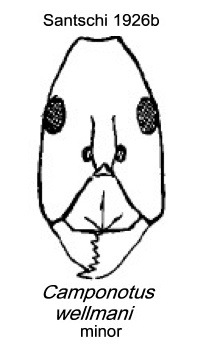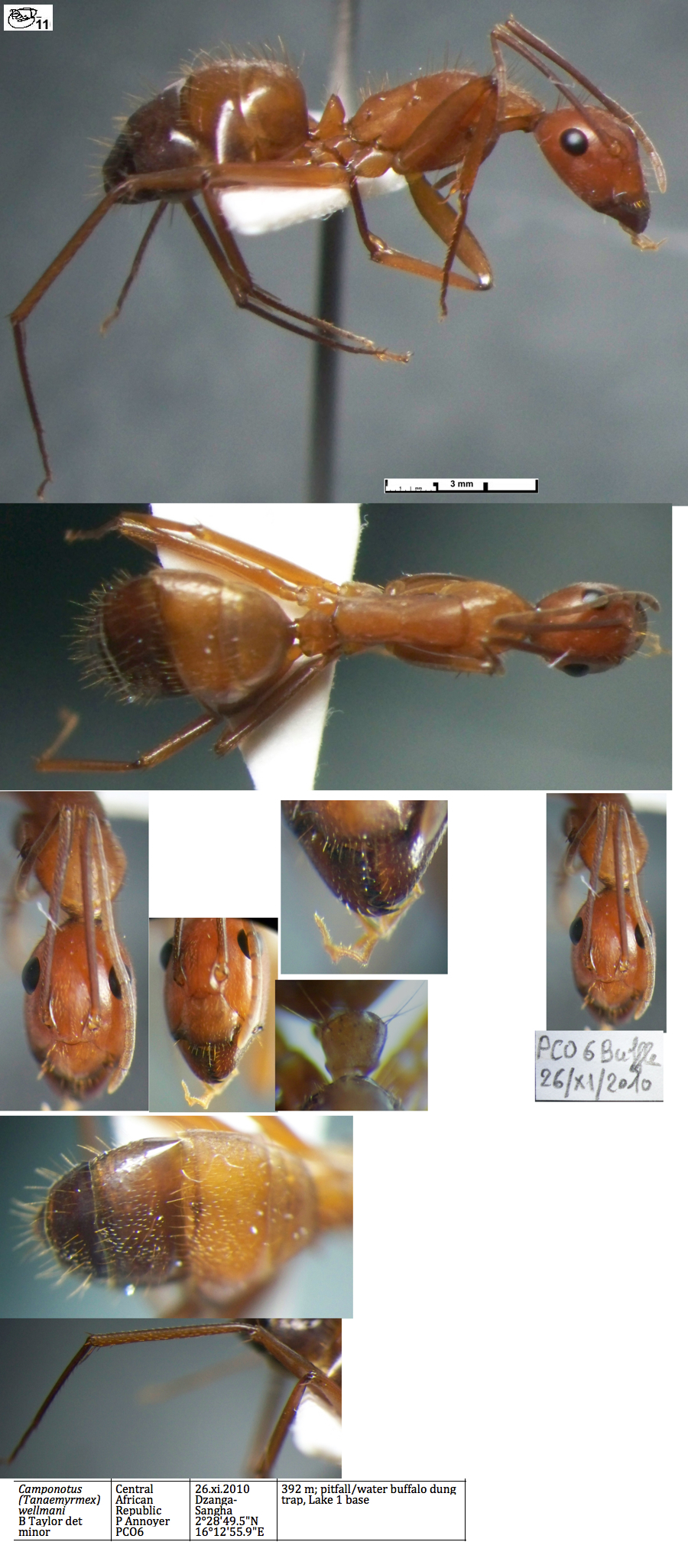Camponotus (Tanaemyrmex) wellmani Forel
  Type location Angola
(Camponotus Wellmani n. sp.,
Forel, 1909b: 67, major & minor workers & queen) Type location Angola
(Camponotus Wellmani n. sp.,
Forel, 1909b: 67, major & minor workers & queen)
subspecies
gamma
(Camponotus (Tanaemyrmex) wellmani
Forel v. gamma n. var.,
Santschi, 1926b: 257, major & minor workers) Zaïre, Makanga
- see http://www.antweb.org/specimenImages.do?code=casent0912079
rufipartis
(Camponotus (Dinomyrmex Wellmanni
For v. rufipartis n. var.,
Forel, 1916: 441, worker, queen & male) Zaïre,
collected by Kohl - see http://www.antweb.org/specimenImages.do?code=casent0910081
all forms described  . .
|
Forel's (1909b) description is at  ; Forel's (1916) description of the major
and of rufipartis is at ; Forel's (1916) description of the major
and of rufipartis is at  ; Santschi's (1926b) description of gamma
is at ; Santschi's (1926b) description of gamma
is at  ; from Makanga, Zaïre. ; from Makanga, Zaïre.
Wheeler (1922) listed four findings of rufipartis
from the Lang & Chapin expedition to Zaïre; and many
reports from central Africa of the type form.
From Guinea, Bernard (1952) reported the
collection of one alate queen at Nion, Mt. Nimba. He noted it as known
from Cameroun and Congo.
|
 Forel's
(1909b) description was - Forel's
(1909b) description was -
MINOR - TL 12-13 mm, HL 3.0, SL 5, posterior tibia 5.7; mandibles
smooth, with several strong, sparse puncturations; external edge near
straight, convex only at the tip, with 7 teeth. Clypeus trapezoidal and
carinate, with a marked anterior lobe. Frontal area transverse,
rhomboid. Frontal carinae close together, sinuous and slightly
divergent. Head 150% longer than anterior width, regularly narrowing
from the anterior border to the articulation border, but that is not
raised as a collar. Sides of head regularly but only mildly convex.
Eyes large and centered at mid-length of the head. Thorax elongated and
slender, mildly convex. Propodeum with declivity shorter than dorsum.
Petiole scale cuneiform, convex on both faces, near truncated at the
summit, slightly higher than long. Tibia slender, subchanneled, with
7-9 tiny oblique spurs and points on the internal edge. Metatarsi
channeled.
Moderately shiny, transversely shagreened in a somewhat uniform
fashion. With long silky, sharp, red brown hairs spaced across whole
body, rising out of punctules. Pubescence sparse, fine, reddish, more
abundant on the rear of the head. Tibiae and scapes with oblique short
but abundant rusty pilosity.
Colour black with slight brown tint. Legs and scapes dark brown;
mandibles and tarsi red brown.
MAJOR - TL 18 mm; HL 5; HW 4.8; shaped as in queen, but more impressed
posteriorly; petiole scale as in minor but higher and less slender;
strong puncturation spaced out.
FEMALE - TL 24 mm - mandibles strongly puncturate, 8 teeth, feebly
convex along external border. Head longer than wide, elongated
trapezoid, slightly widened posteriorly and occiput concave. Thorax
slightly larger than head. Petiole scale biconvex, more than twice as
high as long. Otherwise like minor.
Specimens - minor workers and a queen from Benguela, Angola by
Creighton Wellman; single and only major from Kapema, Kipaila,
south-eastern Zaïre, by Dr Sheffield Neave.
Forel commented it was the parent of Camponotus caesar
but easily distinguished by the shape of the head, with larger
mandibles, crossing over less and with shorter teeth.
There does not appear to be any difference between the
type workers and the "varieties".
|
 The
photomontage is of the type major worker collated
from http://www.antweb.org/specimen.do?name=casent0910079 The
photomontage is of the type major worker collated
from http://www.antweb.org/specimen.do?name=casent0910079
|
 The
photomontage is of the type minor worker collated
from http://www.antweb.org/specimen.do?name=casent0910080 The
photomontage is of the type minor worker collated
from http://www.antweb.org/specimen.do?name=casent0910080
|
Oxford University Museum
specimens
Camponotus (Tanaemyrmex) wellmani
B Taylor det.
|
Central African
Republic
Degallier
|
20.vii.1981
Bozo
18°30' N
5°10' E
|
under bark
|
5
|
 |
Camponotus (Tanaemyrmex) wellmani
B Taylor det.
|
Central African
Republic
P Annoyer
ED
|
30.i.2005
Dzanga-Sangha
02°49’07.9" N
16°09’28.3" E
|
Camp 2; UV,
18h30-3h00, en bordure du fleuve Sangha; 377m asl
|
1
|
|
Camponotus (Tanaemyrmex) wellmani
B Taylor det.
|
Central African
Republic
P Annoyer
DE
|
2005
Dzanga-Sangha
02°49’07.9" N
16°09’28.3" E
|
Camp 2; UV, "Bois
Sangha"; 377m asl
|
1
|
|
Camponotus (Tanaemyrmex) wellmani
B Taylor det. |
Central African
Republic
P Annoyer
PCO6
|
26.xi.2010
Dzanga-Sangha
2°28'49.5"N
16°12'55.9"E
|
392 m; pitfall/water
buffalo dung trap, Lake 1 base
|
1
|
 |
Camponotus (Tanaemyrmex) wellmani
B Taylor det.
major
|
Central African
Republic
P Annoyer
PCO6
|
27.xi.2010
Dzanga-Sangha
2°28'49.5"N
16°12'55.9"E
|
392 m; pitfall/water
buffalo dung trap, Lake 1 base
|
1
|
 |
|
 Major Major
The photomontage is of a major worker from Central
African Republic, Bozo; collector Degallier, sent to me by Peter
Hlavac.
|
 Media Media
The photomontage is of a media worker from Central
African Republic, Bozo; collector Degallier, sent to me by Peter
Hlavac.
|
 Media Media
The photomontage is of a minima worker from Central
African Republic, Bozo; collector Degallier, sent to me by Peter
Hlavac.
|
 Major Major
The photomontage is of a major worker from Central
African Republic,
Dzanga-Sangha; collector P Annoyer (PCO6).
|
 Minor Minor
The photomontage is of a minima worker from Central
African Republic,
Dzanga-Sangha; collector P Annoyer (PCO6).
|
|